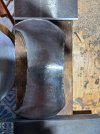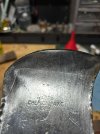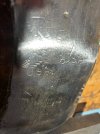PhilipWimberly
Gold Member
- Joined
- Oct 31, 2023
- Messages
- 78
Cleaned this one up a little more than usual because I wanted to be able to show you guys a few things I couldn't get good pics of...
My main question is what you would do with this bit? I think you can see the toe is worn/chipped/sharpened past the line of the bit iron. My best idea is just to shape the heel down as little as possible until I'm as happy as I can be with the aesthetics. (Shrug). Lose as little as possible and hope it looks a little like a working tool? Any other thoughts? Water it and hope the toe grows back?
Related question...I've never used an axe hard enough or long enough to wear the bit. What were the users doing that would cause the toes to wear down so much more than the heels?
My other question is about the USA embossing. I've never seen this on the Sager Chems before, but this is the "youngest" one I have. There are 2 on each side. Has anyone else seen this?
My main question is what you would do with this bit? I think you can see the toe is worn/chipped/sharpened past the line of the bit iron. My best idea is just to shape the heel down as little as possible until I'm as happy as I can be with the aesthetics. (Shrug). Lose as little as possible and hope it looks a little like a working tool? Any other thoughts? Water it and hope the toe grows back?
Related question...I've never used an axe hard enough or long enough to wear the bit. What were the users doing that would cause the toes to wear down so much more than the heels?
My other question is about the USA embossing. I've never seen this on the Sager Chems before, but this is the "youngest" one I have. There are 2 on each side. Has anyone else seen this?



